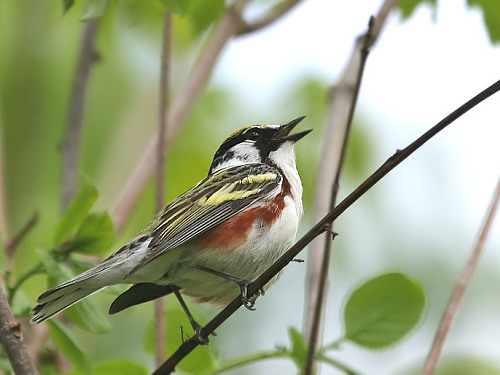Ponaganset Road - Foster
This is a wonderful protected spot in Northwestern RI. Cerulean Warbler bred here in the past, and maybe someday its song will be heard again. Pileated Woodpecker and Common Raven are being seen more often. Although Ruffed Grouse is getting to be a very difficult bird to find in RI, one can sometimes be heard drumming. Walking the road, with the waterfall, reservoir, rushing river and lots of birdsong, is truly a joy of springtime.
View Larger Map
Location
Foster, RIOwner/manager
Providence Water Supply Reservoir SystemDirections
Ponaganset Road and Rams Tail Road are located between Rt 6 and Rt 102 in Foster.
Habitat
Mature woods, small fields, with Barden Reservoir, a waterfall, and streams of the Ponaganset River.
Description

Pileated Woodpecker - Photo by Michelle St. Sauveur
These roads traverse mature decidous and coniferous woods, with the Barden Reservoir, and a large man made waterfall, the rushing Ponagansett River, and a few small fields. Starting at the junction of Route 102 and Ponagansett Road, the first .5 mile is paved. The large pine trees along this stretch often have Blackburnian Warbler, and listen for Winter Wren in the tangled understory. At the bridge over the river, where you see the waterfall, listen for Louisianna Waterthrush. Continuing up the hill is a cutover area that can be very productive, with records of Olive-sided Flycatcher here. At .8 mile there is a pullout near some Red Pines. Look over the water for swallows. Around the bend from here look for Blue-gray Gnatcatcher and Acadian Flycatcher. Least Flycatcher is possible anywhere. Along the incline just past the Red Pines is good for Worm-eating Warbler. At 1.2 miles there is a low spot with a stream. Kentucky Warbler has been found here, and Wood Thrush and American Redstarts are common. Up the hill at 1.4 miles is the farmhouse. In winter, if the feeders have food, there can be Pine Siskins and Common Redpolls. Check the field after the barn for Eastern Bluebird and Wild Turkey. Central Pike is 1.9 miles from the start. Go left here, and look for Rough-winged Swallows nesting under the bridge. Take the next right onto Rams Tail Road. The first .4 mile before the houses can produce Winter Wren, Mourning Warbler, Louisiana Waterthrush and other migrants. The bridge at 3.6 miles always has Louisiana Waterthrush. Behind the cemetery after the bridge is a large marsh that has had Pileated Woodpecker and is very good for Hairy Woodpecker.
All birding must be done from the road and at various pullouts along the road.
Best Seasons to Visit
Spring and to a lesser extent, fall.Birds Most Likely to Be Seen

Chestnut-sided Warbler - Photo by Michelle St. Sauveur
Breeding birds include: Acadian and Least Flycatcher, Brown Creeper, Warbling and Yellow-throated Vireo, Baltimore Oriole, Pileated Woodpecker, Red-bellied Woodpecker, Barred Owl, Scarlet Tanager, Rose-breasted Grosbeak, Blue-gray Gnatcatcher, Pine Warbler, Worm-eating Warbler, Blue-winged Warbler, Chestnut-sided Warbler, Louisiana Waterthrush, Wood Thrush.
Spring and Fall migrants include: Cliff Swallow, Blackburnian, Nashville, Black-throated Blue, Tennessee, Palm, Wilson’s, and Mourning Warbler. Yellow-bellied Sapsucker, Red-breasted Nuthatch, Indigo Bunting, and Winter Wren. There are several records in fall of Olive-sided Flycatcher. Wild Turkey, Common Raven and Bald Eagles are possible anytime.
Common Merganser and Ring-necked Ducks occur on the Reservoir.
Potential obstacles
- Biting insects in spring. Annoying black flies.
- The area is getting popular with dog walkers.
- Birding is done on the roads only, no access to woods, other than the cemeteries.